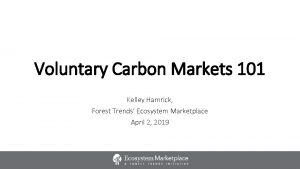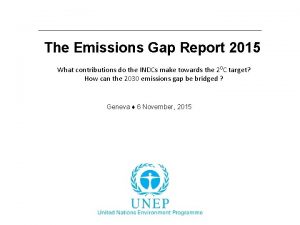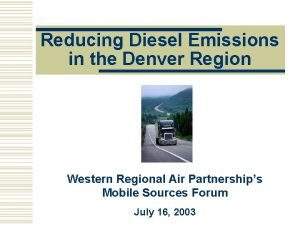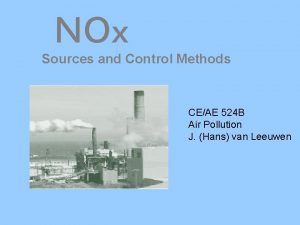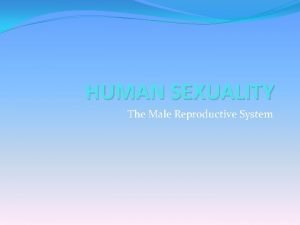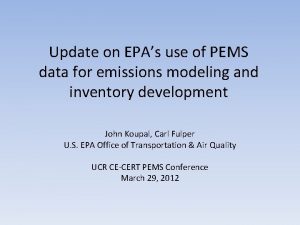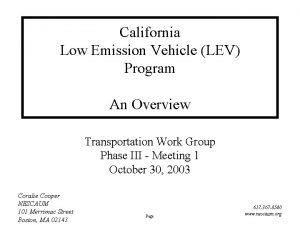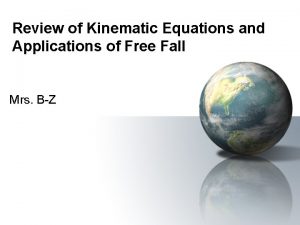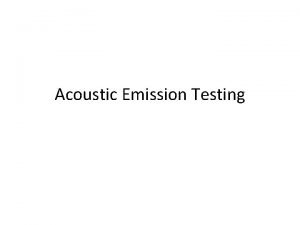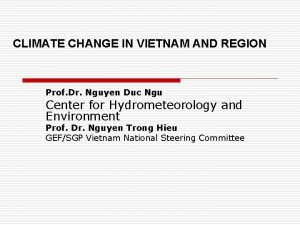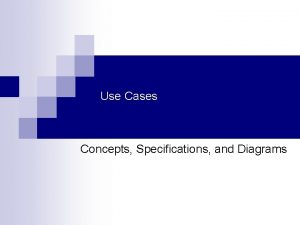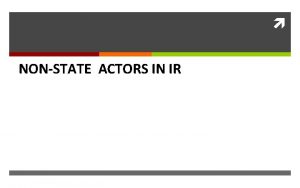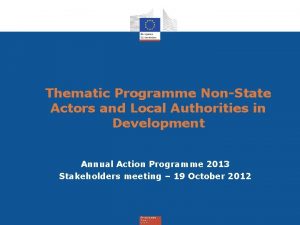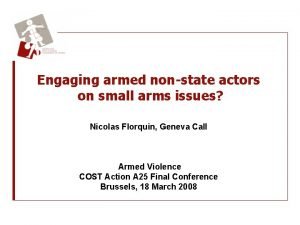The Emissions Gap and Role of NonState Actors



















- Slides: 19

The Emissions Gap and Role of Non-State Actors Nihit Goyal, Data-Driven Enviro. Lab, Yale-NUS College 04 November 2019 Photo by NASA on Unsplash

Global greenhouse gas emission levels for major emitters and per type of gas 2

NDC contributions and the emissions gap Annual global total greenhouse gas emissions as per EGR 2018 (Gt. CO 2 e). The findings of EGR 2019 are likely to be similar. No policy baseline Global total emissions 65 Gt. CO 2 e (range: 60 -70) Current policy scenario Global total emissions 59 Gt. CO 2 e (range: 56 -60) Unconditional NDC scenario Global total emissions 56 Gt. CO 2 e (range: 52 -58) Conditional NDC scenario Global total emissions 53 Gt. CO 2 e (range: 49 -55) 2°C pathways Global total emissions 40 Gt. CO 2 e (range: 38 -45) 1. 5°C pathways Global total emissions 24 Gt. CO 2 e (range: 22 -30) 3

NDC contributions and the emissions gap Annual global total greenhouse gas emissions (Gt. CO 2 e) 4

Increasing, but inadequate, economy-wide climate commitment Source: Höhne et al. (2019). Bridging the Gap: Enhancing Mitigation Ambition and Action at G 20 Level and Globally. An Advance Chapter of The Emissions Gap Report 2019. United Nations Environment Programme. Nairobi.

Limited adoption of 100% renewable electricity target; slow progress on coal phase out Source: Höhne et al. (2019). Bridging the Gap: Enhancing Mitigation Ambition and Action at G 20 Level and Globally. An Advance Chapter of The Emissions Gap Report 2019. United Nations Environment Programme. Nairobi.

Increasing shift from internal combustion engine but no commitment on shipping, aviation, freight transport Source: Höhne et al. (2019). Bridging the Gap: Enhancing Mitigation Ambition and Action at G 20 Level and Globally. An Advance Chapter of The Emissions Gap Report 2019. United Nations Environment Programme. Nairobi.

The Paris Agreement and Non-state Climate Action 1) Individual commitments 2) Single initiatives 3) International cooperative Initiatives (ICIs)

Cities, companies, and international initiatives as policy actors Source: UNEP (2018). The Emissions Gap Report 2018. United Nations Environment Programme, Nairobi


Assessing individual non-state climate actions Need data innovation, better reporting, and intelligent tracking to improve the process

Source: New. Climate Institute, Data-Driven Lab, PBL, German Development Institute/Deutsches Institut für Entwicklungspolitik (DIE), Blavatnik School of Government, University of Oxford. Global climate action from cities, regions and businesses: Impact of individual actors and cooperative initiatives on global and national emissions. 2019 edition

Source: New. Climate Institute, Data-Driven Lab, PBL, German Development Institute/Deutsches Institut für Entwicklungspolitik (DIE), Blavatnik School of Government, University of Oxford. Global climate action from cities, regions and businesses: Impact of individual actors and cooperative initiatives on global and national emissions. 2019 edition

Global climate action from cities, regions and businesses: Impact of individual actors and cooperative initiatives on global and national emissions. New. Climate Institute, Data-Driven Lab, PBL, German Development Institute/Deutsches Institut fu r Entwicklungspolitik (DIE), Blavatnik School of Government, University of Oxford. 2019 edition. Calculating additionality to account for overlap between NDCs and non-state action

Global climate action from cities, regions and businesses: Impact of individual actors and cooperative initiatives on global and national emissions. New. Climate Institute, Data-Driven Lab, PBL, German Development Institute/Deutsches Institut fu r Entwicklungspolitik (DIE), Blavatnik School of Government, University of

Major gaps in action, particularly in the Global South

Untapped potential in non-energy sectors

Furthering climate action Increase ambition through sectoral diversification (for example, non-CO 2 emissions) Use data and technologies to identify potential for local action (for example, for nature-based solutions) Track and evaluate performance using next-generation tools (such as blockchain)

Thank you nihit. goyal@yale-nus. edu. sg
 Voluntary carbon market
Voluntary carbon market Un emissions gap report
Un emissions gap report Five actors were competing for the leading role in the play
Five actors were competing for the leading role in the play Bogʻlangan qoʻshma gaplar
Bogʻlangan qoʻshma gaplar Specification gap is gap between
Specification gap is gap between Volkswagen emissions scandal ethics
Volkswagen emissions scandal ethics Sparse matrix operator kernel emissions
Sparse matrix operator kernel emissions Diesel emissions denver
Diesel emissions denver Sources of nox emissions
Sources of nox emissions Parts of sperm cell
Parts of sperm cell Pems emissions modeling
Pems emissions modeling Flame test results table
Flame test results table California lev
California lev Kinematic equations examples
Kinematic equations examples Using citys heat reduce emissions
Using citys heat reduce emissions Acoustic emissions testing
Acoustic emissions testing Ghs emissions
Ghs emissions Particulates can be removed from smokestack emissions by
Particulates can be removed from smokestack emissions by Azure web role worker role example
Azure web role worker role example Use case primary and secondary actors
Use case primary and secondary actors
